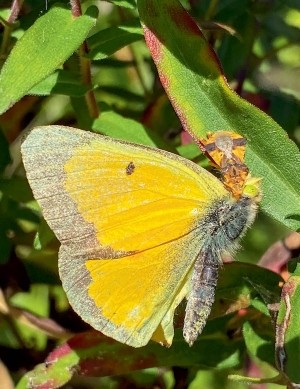
Ambush bugs have sufficient cold tolerance to remain active late into the season, until hard frosts occur. As their name suggests, these insects sit motionless on plants, waiting for prey such as flies, small moths and butterflies, and beetle larvae. This hunting technique, along with strong forelegs and mouthparts arranged in a single knifelike beak, allows them to capture insects much bigger than themselves. In this case, a sulphur butterfly failed to notice the jagged ambush bug (Phymata species), which quickly grabbed its prey, delivered an injection of immobilizing and digestive fluid, and then drank the liquefying nutrients from the butterfly’s body.

